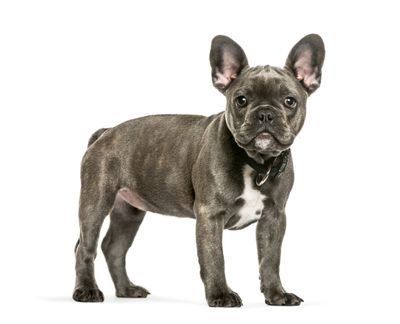"Fad colors" from a Historical Perspective
Why we include "color" in our program
There is a lot of misinformation circulating about so-called “non-standard” colors in French Bulldogs. In reality, colors such as Dark Iron Gray, Liver, and tan points are naturally occurring traits within the breed. Historical records show that until 1911, there was no color discrimination in the breed standards; breeders focused primarily on overall structure and temperament rather than strictly on coat color. The French Bulldog Club of America’s documentation on the history of color in the breed confirms that these hues have long been a natural part of the French Bulldog’s genetic makeup.
In our program, we take pride in our rigorous breeding practices that prioritize the quality, health, structure, and temperament of our puppies—regardless of their coat color. We believe that the rich diversity of natural colors is part of what makes the French Bulldog so unique, and we are committed to preserving this heritage while upholding the highest breeding standards. By doing our due diligence, we ensure that every French Bulldog we breed is a true representation of the breed’s authentic history and excellence, reflecting both its genetic diversity and its enduring charm.
Click here for the original breed standards from 1897 on: https://frenchbulldogclub.org/wp-content/uploads/2014/03/History-of-Color-FBDCA-Standard.pdf

What about Fluffy Frenchies?
Why we include "fluffy coats" in our program
The French Bulldog Club of America (FBDCA) has published extensive historical documents—including their “History of Color” publication—that examine original studbook records and early breed standards. These archives reveal that, well into the early 20th century, there was much more variability in coat texture and color among French Bulldogs, with some specimens exhibiting longer, softer coats that many today refer to as “fluffy.” Additionally, the American Kennel Club (AKC) maintains digitized records and historical registries (accessible through institutions like the Library of Congress) that provide further documentation of the breed’s natural diversity. Academic publications and breed histories available in canine genetics literature also discuss these early variations, reinforcing that traits like a fluffier coat are not a modern aberration but rather a natural part of the French Bulldog’s heritage.
These sources collectively demonstrate that the diversity in coat types—including what is sometimes labeled as “fluffy”—was present before strict color and texture standards were imposed around 1911. This historical perspective underscores that the long, soft coat seen in some French Bulldogs is simply one expression of the breed’s genetic legacy, a fact that continues to be recognized by reputable breed organizations and documented in archival records.
The image on the right is from a book called Le Bouledogue Français from 1933! It shows the pure-bred French Bulldogs have had this long hair gene for much longer than most think.

What we DO NOT do
Big Ropes
"Big rope" refers to an excessively large roll of skin over the dog's nose—a trait that many breeders are looking for in French Bulldogs. One of the primary reasons for not breeding dogs with this feature is that it an overly pronounced nasal roll can lead to health issues. Excessive skin in this area may create pockets where moisture, dirt, and bacteria can accumulate, potentially resulting in skin irritations or infections. This exaggerated roll can also extend over the snout to cover the nare, making it hard for the dog to breathe.
Wide Chests and Bowed Legs
French Bulldogs that have excessively broad chests and bowed legs—often described as having an "exotic bully" appearance—can face a number of significant health and structural challenges. A broad chest can contribute to respiratory difficulties by placing extra pressure on the ribcage and reducing lung capacity, while also putting strain on the heart. When combined with bowed legs, the overall balance of the dog's skeletal structure is compromised. This abnormal conformation can lead to improper weight distribution, which in turn increases the risk of joint stress, early-onset arthritis, and chronic orthopedic pain.
Pinks
Albinism—or the presence of the "pink gene"—in French Bulldogs can predispose affected dogs to several health challenges. One of the primary concerns is the reduced production of melanin, which normally provides protection against ultraviolet (UV) radiation. Without this natural protection, dogs with pink pigmentation are at a higher risk of sunburn, chronic skin irritation, and, over time, an increased likelihood of developing skin cancers. Additionally, the lack of pigment in the eyes can lead to ocular issues. Dogs with albinism often exhibit heightened sensitivity to bright light (photophobia), and in some cases, they may develop visual impairments such as nystagmus or other retinal abnormalities.
Another potential issue associated with albinism in various species is congenital deafness. While the incidence in French Bulldogs specifically requires further study, the genetic link between pigmentation and inner ear development suggests that dogs carrying the pink gene might be predisposed to auditory problems. Responsible breeders take these factors into account by carefully evaluating the overall health, structure, and genetic background of their breeding stock. Our breeding program, for example, ensures that we do our due diligence to maintain the highest standards of health and temperament, regardless of coat color, while actively avoiding the propagation of traits that could compromise a dog’s long-term well-being.
A&D Frenchies